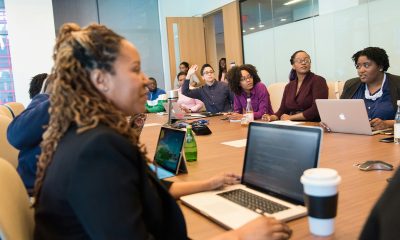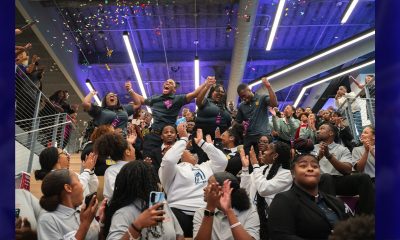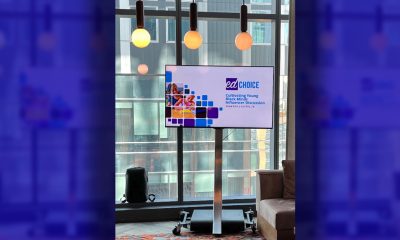Education
Southern University and the Pursuit of Black Excellence
NEW ORLEANS DATA NEWS WEEKLY — Southern University and A&M College System holds the distinction as being the only Historically Black University System in America.
By Edwin Buggage, Editor
Southern University’s has more than 130 years of Excellence in Higher Education. From its beginning to the present day it is at the forefront of educational institutions in the State of Louisiana, their faculty, students, and alumni have positively impacted society at every level.
It continues to produce graduates that are leaders in many fields of endeavor and lighting the road to freedom, justice and equality.
Southern University and A&M College System also holds the distinction as being the only Historically Black University System in America.
When accounting for all the five campuses throughout Louisiana that includes, Southern University, Baton Rouge; Southern University, New Orleans; Southern University Law Center; Southern University, Shreveport; and the Southern University Agricultural Research and Extension Center, total enrollment exceeds more than 15,000 students coming from 46 states and from at least 40 foreign countries.
Southern University A&M (Baton Rouge) The Early Years and the Continuing the Spirit of Black Excellence
What began as a dream more than 136 years ago is today a living legacy of determination, commitment, and success. The Southern University and A&M College System is the only Historically Black University System in the United States.
Southern University and A&M College (often referred to as Southern University, Southern, SUBR or SU) is a public Historically Black College University (HBCU) in the Scotlandville area of Baton Rouge, Louisiana. The campus encompasses 512 acres, with an agricultural experimental station on an additional 372-acre site, five miles north of the main campus.
The university is the largest HBCU in Louisiana. The history of Southern University is one steeped in a race of people striving for equality and a chance to live with human dignity, full equality and access to opportunities that an education would afford them after the end of the Civil War during the Reconstruction Period. This tradition continues to this day.
An example of this living spirit is Bill Tucker, who serves as a member of the Southern University System Foundation, Board of Directors where he chairs its Investment Committee. He is a member of the University Club, a charter member of the 1880 Society, and a life member of the Southern University Alumni Federation.
In addition, he is a graduate of Southern University who is a venture capitalist who believes the early investment in his potential at an HBCU planted the seeds to him being successful. Being raised by his mother after the untimely death of his father before his third birthday. Today he invests his time and resources to help young people get a quality education.
“HBCU’s continue to be important and if it were not for Southern University providing me with the opportunity for an education, I don’t know what my life would have been like. Today kids have many more opportunities and access to education, but there are still those who are like Bill Tucker who arrived at Southern in 1969 looking for an opportunity for a better life and Southern provided that for me with a supportive staff, faculty and administration.”
Freedom and a Matter of Color: A History of Southern University Law Center (Baton Rouge)
On December 16, 1946, in response to a lawsuit by an African-American resident seeking to attend law school at a state institution, the Louisiana State Board of Education took “positive steps to establish a Law School for Negroes at Southern University to be in operation for the 1947-1948 session.”
Plans for the law school were approved by the State Board of Education at its January 10, 1947, meeting. On June 14, 1947, the Board of Liquidation of State Debt appropriated $40,000 for the operation of the school. The Southern University Law School was officially opened in September 1947 to provide legal education for African-American students.
Southern University Law Center graduates, beginning with the Legendary Civil Rights Attorney, Political Leader, and Educator Jesse N. Stone, Jr., Alvin Basile Jones, Leroy White, Ellyson Fredrick Dyson, and Alex Louis Pitcher of the Class of 1950, have spread across the state and nation as trailblazers in the legal profession, securing equal rights for others. To date, the Law Center has more than 2,500 graduates and has one of the nation’s most racially diverse law schools’ background.
The mission and tradition of the Law Center continues to provide access and opportunity to a diverse group of students from under-represented racial, ethnic, and socio-economic groups to obtain a high-quality legal education with special emphasis on the Louisiana Civil Law. Additionally, their mission is to train a cadre of lawyers equipped with the skills necessary for the practice of law and for positions of leadership in society.
Expanding its Vison and Mission: SU Agricultural Research and Extension Center (Baton Rouge)
Founded in 2001 in Baton Rouge, Southern University Agricultural Research and Extension Center’s, mission is to conduct basic and applied research, disseminate information to Louisiana residents and to help them address their scientific, technical, social, economic and cultural needs.
The Ag Center encompasses the Southwest Center for Rural Initiatives, the Center for Small Farm Research, the Cooperative Extension Program, the SU Livestock Show and its state-of-the-art arena, and a 385-acre Agricultural Research Facility.
Giving Educational Opportunities to All: SUSLA (Shreveport) Boasts Being the only HBCU in Louisiana
Founded in Shreveport in 1964 SUSLA is an institute which it’s mission ranges from community workforce training or preparing students for four-year schools. With its diverse approach to preparing and educating its students to leading the way to educational and professional success. Southern University at Shreveport in its over 50 years is committed to ensuring they leave an indelible footprint in our community and beyond.
It also holds the distinction as the only HBCU Comprehensive Community College in Louisiana, SUSLA serves an ever-growing population of full-time and part-time students. At SUSLA, they offer a high-quality education and opportunities for our students which in turn contributes to the vibrancy of our local, state, national and global economic community.
SUNO Continuing to Build Bridges of Opportunity
SUNO has been a jewel to the New Orleans Community educating and producing city leaders in many fields of endeavor. Located on a 17-acre site located in Historic Pontchartrain Park, a sub-division of primarily African-American single-family residences in Eastern New Orleans.
Wesley Bishop knows this campus well, once as a student where he was Student Body President and today where he serves as Vice-Chancellor for Academic Affairs; a post he has held for over two-decades.
Speaking of the history and importance of Southern University at New Orleans he says, “As the only Public, Historically Black College/University (HBCU) in the City of New Orleans, Southern University at New Orleans provides an awesome education in a small-class, nurturing environment. While it’s primary focus is to provide access to traditional students in the New Orleans Metropolitan Area, it has long educated non-traditional, working adults.”
SUNO continues to be important to New Orleans in so many ways explain Bishop, “Simply put, if there weren’t an institution like SUNO, we would need to build one today. It provides quality educational opportunities to both traditional college aged students and recently that the majority of African- Americans who have bachelor’s degrees in New Orleans earned their degrees at SUNO. Think about it – your teachers and superintendents, business people, police officers and chiefs, first responders, social workers, college chancellors, lawyers, judges and law school deans – all got their start at 6400 Press Drive.
HBCU’s and the Pursuit of Black Excellence
HBCU’s are beacons of light that lead to the road of freedom, justice and equality for African-Americans. They are sacred institutions that must be preserved.
HBCU’s continue to shape the pursuit of Black Excellence. A fact not lost on Bishop, “My experience as a student at Southern University at New Orleans embodied me with the belief that nothing was beyond my grasp and that all dreams could be achieved. It shaped my belief in Black Excellence by exposing me to HBCU faculty and graduates who had excelled in every field of endeavor. That experience let me know that it was possible for me to succeed as well and now I am passing that on to the next generation of students.”
Community
AG Bonta Says Oakland School Leaders Should Comply with State Laws to Avoid ‘Disparate Harm’ When Closing or Merging Schools
California Attorney General Rob Bonta sent a letter this week to the Oakland Unified School District (OUSD) Board of Education saying the district has a duty to comply with state education and civil rights laws to protect students and families from “disparate harm,” such as segregation and discrimination, if the district goes ahead with school closures, mergers or consolidations in 2025-2026.
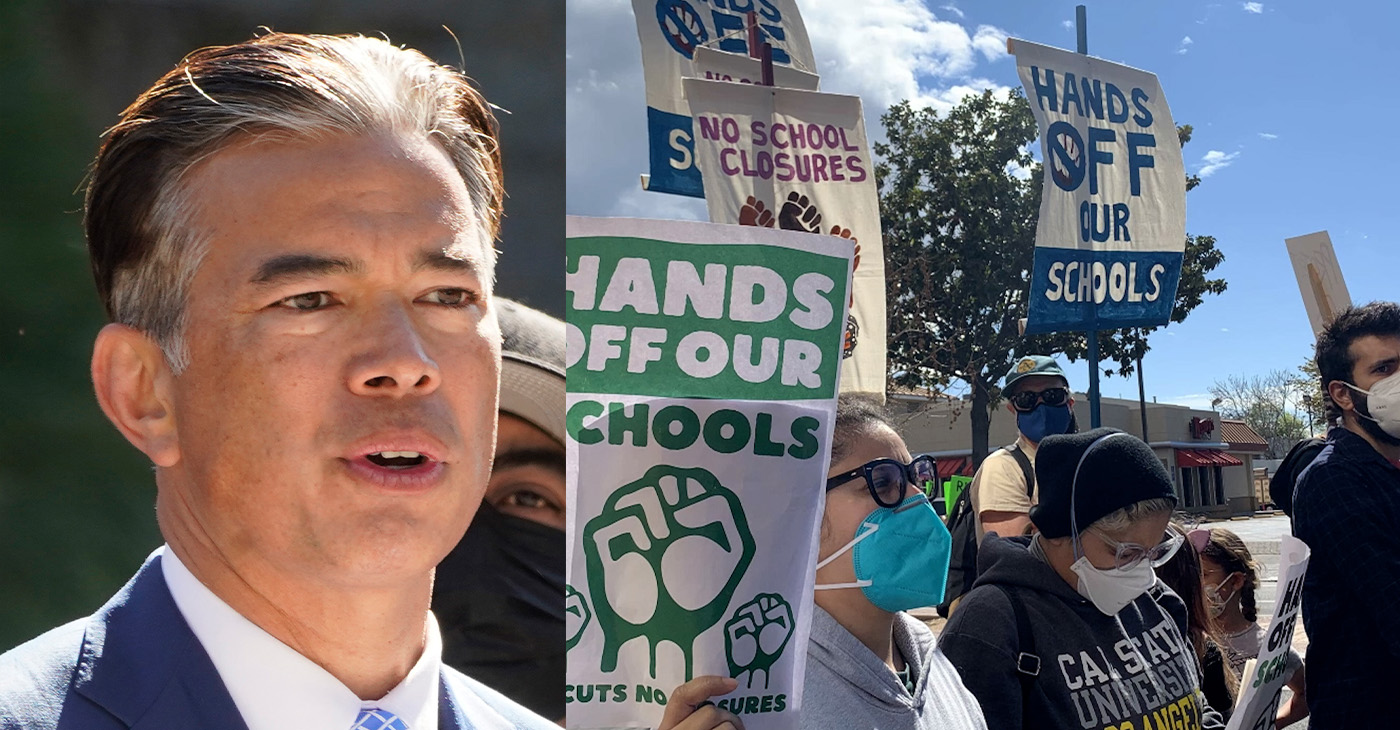
AG Bonta said DOJ investigation of 2022 closure decisions would have negatively impacted Black and low-income families.
By Post Staff
California Attorney General Rob Bonta sent a letter this week to the Oakland Unified School District (OUSD) Board of Education saying the district has a duty to comply with state education and civil rights laws to protect students and families from “disparate harm,” such as segregation and discrimination, if the district goes ahead with school closures, mergers or consolidations in 2025-2026.
The letter and an accompanying media release announced the findings of the California Department of Justice’s (DOJ) investigation into the OUSD Board’s Feb. 8, 2022, decision to close Parker Elementary, Brookfield Elementary, Carl B. Munck Elementary, Fred T. Korematsu Discovery Academy, Grass Valley Elementary, Horace Mann Elementary, and Community Day School and eliminate grades 6-8 of Hillcrest Elementary and La Escuelita Elementary.
“All school districts and their leadership have a legal obligation to protect vulnerable children and their communities from disparate harm when making school closure decisions,” said Attorney General Bonta.
“The bottom line is that discrimination in any form will not be tolerated,” he said. “I am committed to working with OUSD’s leadership to achieve successful outcomes for students.
“My office will continue to monitor OUSD’s processes and decision-making as it moves forward with the required community engagement, equity impact analysis, and planning to implement any future closures, mergers, or consolidations” to ensure compliance with California’s Constitution, AB 1912, and anti-discrimination laws.
By press time, the school district did not respond to a request for comment from OUSD.
The DOJ’s findings showed that the February 2022 decision, later partially rescinded, would have disproportionately impacted Black and low-income elementary students, as well as high-need students with disabilities, according to the media release.
The Attorney General outlined concerns about criteria OUSD has announced that it may rely on to determine future closures, mergers, and consolidations and provided recommendations to ensure OUSD does not violate state law, including prohibitions against closure decisions that reinforce school segregation or disproportionately impact any student group as required by the State Constitution, AB 1912, and anti-discrimination laws.
According to AB 1912, passed in September 2022, financially distressed school districts contemplating school closures, mergers, or consolidations must engage the community before closing schools; conduct an equity impact assessment; and provide the public with the set of criteria the district plans to utilize to make decisions.
In the letter, DOJ identified a “problematic” approach to planning for closing schools in 2025-2026 and “strongly recommends” steps OUSD should take going forward.
- “Take affirmative steps to ensure that its enrollment and attendance boundary and school closure decisions alleviate school segregation and do not create disproportionate transportation burdens for protected subgroups.”
- Don’t solely utilize criteria such as school facilities’ conditions, school operating costs, and school capacity without also including an assessment of past and present inequities in resources “due to educational segregation or other causes.”
- Some of OUSD’s proposed guidelines “may improperly penalize schools serving students with disabilities and students who have high needs.”
- The district’s decisions should also include “environmental factors, student demographics and feeder attendance patterns, transportation needs, and special programs.”
- Avoid overreliance on test scores and other quantitative data without also looking at “how each school is serving the needs of its specific student body, especially as it relates to historically marginalized communities.”
- “Engage an independent expert to facilitate community input and equity impact.”
The letter also emphasized that DOJ is willing to provide “feedback and consultation at any time during the process to ensure that OUSD’s process and outcomes are legally compliant and serve the best interests of the school community and all of its students.”
Art
Marin County: A Snapshot of California’s Black History Is on Display
The Marin County Office of Education, located at 1111 Las Gallinas Ave in San Rafael, will host the extraordinary exhibit, “The Legacy of Marin City: A California Black History Story (1942-1960),” from Feb. 1 to May 31, 2024. The interactive, historical, and immersive exhibit featuring memorabilia from Black shipyard workers who migrated from the South to the West Coast to work at the Marinship shipyard will provide an enriching experience for students and school staff. Community organizations will also be invited to tour the exhibit.

By Post Staff
The Marin County Office of Education, located at 1111 Las Gallinas Ave in San Rafael, will host the extraordinary exhibit, “The Legacy of Marin City: A California Black History Story (1942-1960),” from Feb. 1 to May 31, 2024.
The interactive, historical, and immersive exhibit featuring memorabilia from Black shipyard workers who migrated from the South to the West Coast to work at the Marinship shipyard will provide an enriching experience for students and school staff. Community organizations will also be invited to tour the exhibit.
All will have the opportunity to visit and be guided by its curator Felecia Gaston.
The exhibit will include photographs, articles and artifacts about the Black experience in Marin City from 1942 to 1960 from the Felecia Gaston Collection, the Anne T. Kent California Room Collection, The Ruth Marion and Pirkle Jones Collection, The Bancroft Library, and the Daniel Ruark Collection.
It also features contemporary original artwork by Chuck D of the Rock and Roll Hall of Fame group Public Enemy, clay sculptures by San Francisco-based artist Kaytea Petro, and art pieces made by Marin City youth in collaboration with Lynn Sondag, Associate Professor of Art at Dominican University of California.
The exhibit explores how Marin City residents endured housing inequities over the years and captures the history of plans to remove Black residents from the area after World War II. Throughout, it embodies the spirit of survival and endurance that emboldened the people who made Marin City home.
Felecia Gaston is the author of the commemorative book, ‘A Brand New Start…This is Home: The Story of World War II Marinship and the Legacy of Marin City.’ Thanks to the generous contribution of benefactors, a set of Felecia’s book will be placed in every public elementary, middle, and high school library in Marin.
In addition, educators and librarians at each school will have the opportunity to engage with Felecia in a review of best practices for utilizing the valuable primary sources within the book.
“Our goal is to provide students with the opportunity to learn from these significant and historical contributions to Marin County, California, and the United States,” said John Carroll, Marin County Superintendent of Schools.
“By engaging with Felecia’s book and then visiting the exhibit, students will be able to further connect their knowledge and gain a deeper understanding of this significant historical period,” Carroll continued.
Felecia Gaston adds, “The Marin County Office of Education’s decision to bring the Marin City Historical Traveling Exhibit and publication, ‘A Brand New Start…This is Home’ to young students is intentional and plays a substantial role in the educational world. It is imperative that our community knows the contributions of Marin City Black residents to Marin County. Our youth are best placed to lead this transformation.”
The Marin County Office of Education will host an Open House Reception of the exhibit’s debut on Feb. 1 from 4 p.m. – 6 p.m.. All school staff, educators, librarians, and community members are encouraged to attend to preview the exhibit and connect with Felecia Gaston. To contact Gaston, email MarinCityLegacy@marinschools.org
Community
The Year Ahead: Assembly Speaker Rivas Discusses Priorities, Problems
Assembly Speaker Robert Rivas shared his legislative priorities and vision for the future of California during a luncheon hosted by the Public Policy Institute of California (PPIC) in downtown Sacramento.
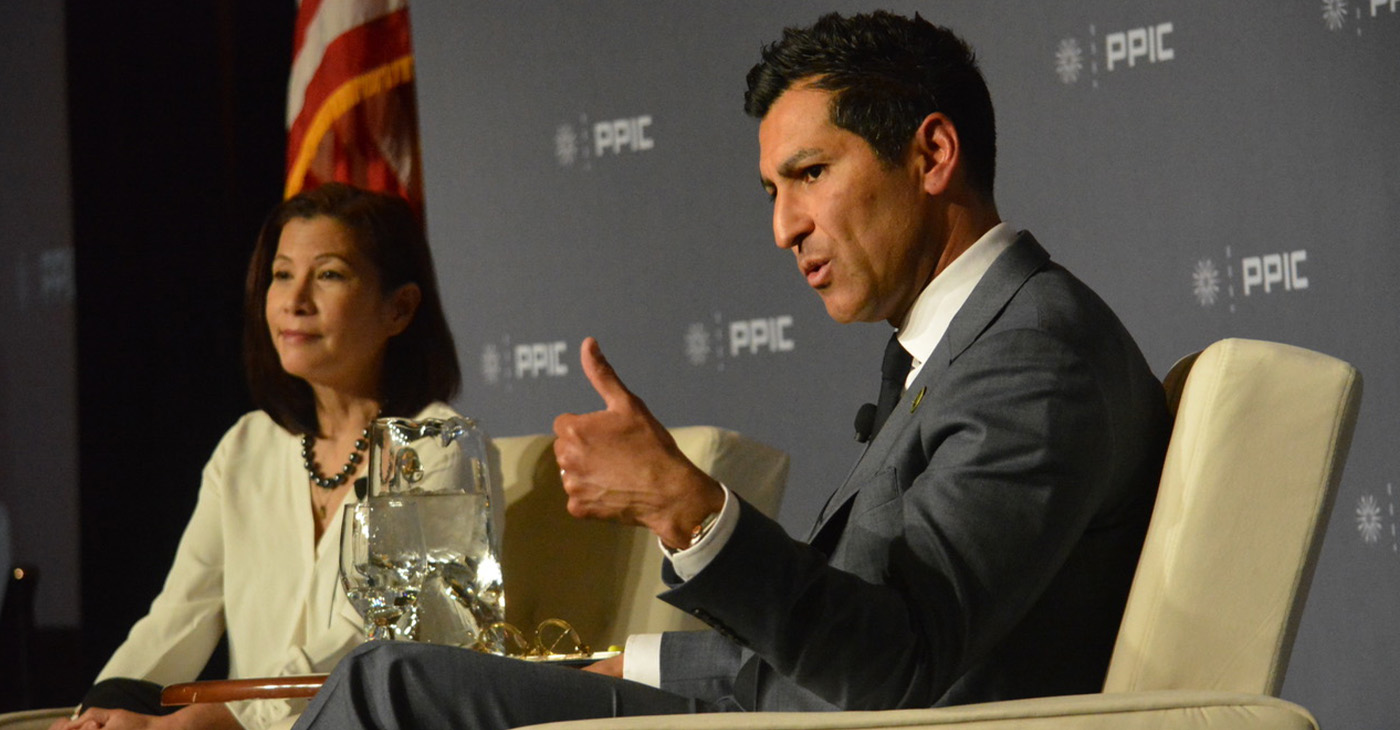
By Antonio Ray Harvey, California Black Media
Assembly Speaker Robert Rivas shared his legislative priorities and vision for the future of California during a luncheon hosted by the Public Policy Institute of California (PPIC) in downtown Sacramento.
Titled a “Conversation with Assembly Speaker Robert Rivas” for PPIC’s 2024 Speaker Series on California’s Future, the 44-year-old Democrat lawmaker from Hollister, who represents the 29th Assembly District, is the 71st speaker of the Assembly.
The discussion at the Sheraton Hotel took place about two weeks after Gov. Gavin Newsom presented his $291 Billion January budget proposal.
“These are going to be difficult times,” Rivas said of the task of balancing a budget that has been estimated separately by the Department of Finance and Legislative Analyst’s Office to have a deficit between $38 billion and $68 billion. “It’s going to underpin everything we get done this year. It’s going to impact everything.”
PPIC’s Speaker Series on California’s Future allows “leaders, lawmakers, and changemakers with diverse perspectives to participate critically, constructively, and collaboratively in public conversations,” according to PPIC.
PPIC president and Chief Executive Officer Tani Cantil-Sakauye was the moderator of the 60-minute discussion that about 200 guests attended.
Rivas said right after he was sworn in as the Assembly leader that among his top priorities are mental and medical wellness, public safety, affordable housing, homelessness, education, the state’s entry-level scientists’ wages, and climate change.
He added that his goal is to focus on both urban and rural areas across the state, including improving public services and infrastructure. He explained that wildfires, flooding, droughts, and agriculture productivity are additional concerns.
Rivas shared that legislators should have goals of “addressing critical issues” that lead to “progress, affordability, and improving day-to-day” quality of life for all residents in California.
“These issues are consistent across the state. I prioritize no region over the other,” Rivas told Cantil-Sakauye, the former chief justice of the California Supreme Court.
During the question-and-answer portion of the conversation, Michael L. Younger, the Vice President of Workforce, Strategy, and Innovation at Calbright College asked Rivas about how the state can help individuals with workforce training and achieve labor success without relying on traditional colleges and university.
“(I am) speaking to those who may not see themselves on the college track but also have value to society,” Younger asked Rivas.
In his response, Rivas said the labor force needs individuals with work training skills, especially with the rise and usage of artificial intelligence.
“The need to have that transition can’t come soon enough but at the same time we have a responsibility to train displaced workers,” Rivas said.
Carmen-Nicole Cox, director of Government Affairs for American Civil Liberties Union – California Action, asked the Speaker would he accept the “community’s invitation” to take a public health approach to addressing public safety rather than one that criminalizes, demoralizes and focuses on incarceration.
Rivas responded to Cox’s question by explaining that an impartial evaluation of public safety should be made initially before providing a resolution.
“Our approach to addressing public safety is to, first, listen, to be fair throughout our process and to find solutions. Does that include addressing public health? Absolutely,” he said.
-

 Activism4 weeks ago
Activism4 weeks agoOakland Post: Week of March 20 – 26, 2024
-

 #NNPA BlackPress3 weeks ago
#NNPA BlackPress3 weeks agoMayor, City Council President React to May 31 Closing of Birmingham-Southern College
-

 #NNPA BlackPress3 weeks ago
#NNPA BlackPress3 weeks agoCOMMENTARY: D.C. Crime Bill Fails to Address Root Causes of Violence and Incarceration
-

 #NNPA BlackPress3 weeks ago
#NNPA BlackPress3 weeks agoFrom Raids to Revelations: The Dark Turn in Sean ‘Diddy’ Combs’ Saga
-

 #NNPA BlackPress3 weeks ago
#NNPA BlackPress3 weeks agoCOMMENTARY: Lady Day and The Lights!
-

 #NNPA BlackPress3 weeks ago
#NNPA BlackPress3 weeks agoBaltimore Key Bridge Catastrophe: A City’s Heartbreak and a Nation’s Alarm
-

 #NNPA BlackPress3 weeks ago
#NNPA BlackPress3 weeks agoBaltimore’s Key Bridge Struck by Ship, Collapses into Water
-

 Activism3 weeks ago
Activism3 weeks agoOakland Post: Week of March 27 – April 2, 2024


